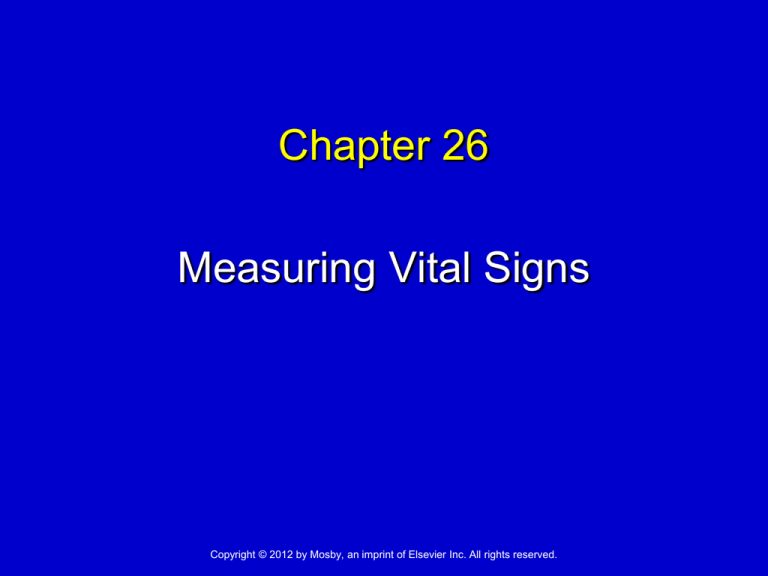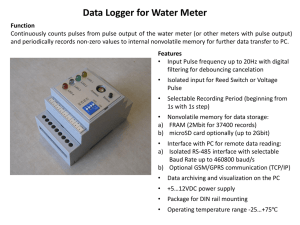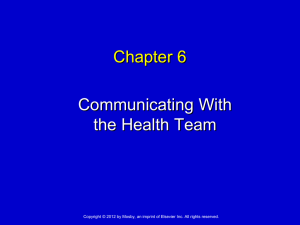
Chapter 26
Measuring Vital Signs
Copyright © 2012 by Mosby, an imprint of Elsevier Inc. All rights reserved.
Vital Signs
Vital signs reflect the function of three body
processes essential for life.
Regulation of body temperature
Breathing
Heart function
The four vital signs of body function are:
Temperature
Pulse
Respirations
Blood pressure
Some agencies consider “pain” to be a vital sign.
Copyright © 2012 by Mosby, an imprint of Elsevier Inc. All rights reserved.
Slide 2
Measuring and Reporting
Vital Signs
A person’s vital signs vary within certain limits.
Vital signs:
Are measured to detect changes in normal body
function
Tell about treatment response
Often signal life-threatening events
Are part of the assessment step in the nursing
process
Copyright © 2012 by Mosby, an imprint of Elsevier Inc. All rights reserved.
Slide 3
Measuring and Reporting
Vital Signs (cont’d)
Vital signs are measured:
During physical exams
When the person is admitted to a health care agency
As often as the person’s condition requires
Before and after surgery, complex procedures, and
diagnostic tests
After some care measures, such as ambulation (walking)
After a fall or other injury
When drugs affect the respiratory or circulatory system
When the person complains of pain, dizziness, lightheadedness, feeling faint, shortness of breath, a rapid
heart rate, or not feeling well
As stated on the care plan
Copyright © 2012 by Mosby, an imprint of Elsevier Inc. All rights reserved.
Slide 4
Measuring and Reporting
Vital Signs (cont’d)
Vital signs show even minor changes in the
person’s condition.
Accuracy is essential when you measure, record,
and report vital signs.
Take vital signs with the person at rest—
lying or sitting, unless otherwise ordered.
Report the following at once:
Any vital sign that is changed from a prior
measurement
Vital signs above the normal range
Vital signs below the normal range
Copyright © 2012 by Mosby, an imprint of Elsevier Inc. All rights reserved.
Slide 5
Body Temperature
Body temperature is a balance between amount
of heat produced and amount lost by the body.
Thermometers measure temperature.
Temperature sites include:
Fahrenheit (F) and centigrade (C) scales are used.
Mouth, rectum, axilla (underarm), tympanic
membrane (ear), and temporal artery (forehead)
Each site has a normal range.
Always report temperatures that are above or
below the normal range.
Fever means an elevated body temperature.
Copyright © 2012 by Mosby, an imprint of Elsevier Inc. All rights reserved.
Slide 6
Body Temperature (cont’d)
Types of thermometers used:
Glass thermometers
Standard electronic thermometers
• Tympanic membrane thermometers
• Temporal artery thermometers
Digital thermometers
Disposable oral thermometers
Temperature-sensitive tape
Pacifier thermometers
Taking Temperatures
The nurse and care plan tell you when to take the
person’s temperature, what site to use, and what
thermometer to use.
Copyright © 2012 by Mosby, an imprint of Elsevier Inc. All rights reserved.
Slide 7
Body Temperature (cont’d)
Electronic thermometers are commonly used.
Some have batteries.
Others are kept in battery chargers when not in use.
Standard electronic thermometers
• Measures temperature in a few seconds
• They have oral (blue) and rectal (red) probes.
Tympanic membrane thermometers
• Measures temperature in 1 to 3 seconds
• Risk of spreading infection is reduced.
Temporal artery thermometers
• Measures temperature in 3 to 4 seconds
• Measures the temperature of the blood in the temporal
artery, which is the same temperature of the blood
coming from the heart
Copyright © 2012 by Mosby, an imprint of Elsevier Inc. All rights reserved.
Slide 8
Body Temperature (cont’d)
Glass thermometers are color coded.
Blue—oral and axillary
Red—rectal
Glass thermometers are reusable. However,
the following are problems:
They take a long time to register.
They break easily.
The person may bite down and break an oral
thermometer.
Copyright © 2012 by Mosby, an imprint of Elsevier Inc. All rights reserved.
Slide 9
Pulse
A pulse is felt every time the heart beats.
The pulse is the beat of the heart felt at an artery
as a wave of blood passes through the artery.
Pulse sites:
Temporal, carotid, brachial, radial, femoral, popliteal,
posterior tibial, and dorsalis pedis (pedal) pulses are
on each side of the body.
Radial pulse is used most often.
Carotid pulse is taken during CPR and other
emergencies.
The apical pulse is felt over the heart.
• This pulse is taken with a stethoscope.
Copyright © 2012 by Mosby, an imprint of Elsevier Inc. All rights reserved.
Slide 10
Pulse (cont’d)
A stethoscope is an instrument used to listen to
the sounds produced by the heart, lungs, and
other body organs.
It is used to take apical pulses and blood pressures.
The device makes sounds louder for easy hearing.
To use a stethoscope:
Wipe the earpieces and diaphragm with antiseptic
wipes before and after use.
Place the earpiece tips in your ears.
Tap the diaphragm gently.
Place the diaphragm over the pulse site.
Prevent noise.
Copyright © 2012 by Mosby, an imprint of Elsevier Inc. All rights reserved.
Slide 11
Pulse (cont’d)
The pulse rate is the number of heart beats
or pulses felt in 1 minute.
The rate varies for each age-group.
The adult pulse rate is between 60 and 100
beats per minute. Report abnormal pulses to
the nurse at once.
Tachycardia is a heart rate of more than 100
beats per minute.
Bradycardia is a heart rate of less than 60 beats
per minute.
Copyright © 2012 by Mosby, an imprint of Elsevier Inc. All rights reserved.
Slide 12
Pulse (cont’d)
Rhythm and force of the pulse
Pulse rhythm should be regular (felt in a pattern with
the same interval between beats).
• An irregular pulse occurs when the beats are not evenly
spaced or beats are skipped.
Force relates to pulse strength.
• A forceful pulse is described as strong, full, or bounding.
• Hard-to-feel pulses are described as weak, thready, or
feeble.
Electronic blood pressure equipment can also count
pulses.
• Some show if the pulse is regular or irregular.
• You need to feel the pulse to determine its force.
Copyright © 2012 by Mosby, an imprint of Elsevier Inc. All rights reserved.
Slide 13
Pulse (cont’d)
You will take radial, apical, and apical-radial
pulses.
You must accurately:
• Count.
• Report and record.
The radial pulse is used for routine vital signs.
• Count the pulse for 30 seconds and then multiply the
•
number by 2.
If the pulse is irregular, count it for 1 minute.
Copyright © 2012 by Mosby, an imprint of Elsevier Inc. All rights reserved.
Slide 14
Pulse (cont’d)
The apical pulse is on the left side of the
chest slightly below the nipple.
It is taken with a stethoscope.
Count the apical pulse for 1 minute.
Count each lub-dub as one beat.
Apical pulses are taken on persons who:
• Have heart disease.
• Have irregular heart rhythms.
• Are taking drugs that affect the heart.
Copyright © 2012 by Mosby, an imprint of Elsevier Inc. All rights reserved.
Slide 15
Pulse (cont’d)
Taking an apical-radial pulse
The apical and radial pulse rates should be the
same.
To see if the apical and radial pulses are equal, two
staff members are needed.
• One takes the radial pulse.
• The other takes the apical pulse.
• Doing this at the same time is called the apical-radial
pulse.
The pulse deficit is the difference between the
apical and radial pulse rates.
• To obtain the pulse deficit, subtract the radial rate from the
apical rate.
Copyright © 2012 by Mosby, an imprint of Elsevier Inc. All rights reserved.
Slide 16
Pulse (cont’d)
Checking pedal pulses
Pedal (dorsalis pedis) pulse is used to check
circulation in the foot.
Doppler ultrasound stethoscope (DUS) is used
when the pedal pulse cannot be felt.
• Your role may include using a DUS. Make sure you:
Have received the necessary training.
Follow the nurse’s directions.
Follow the manufacturer’s instructions.
Copyright © 2012 by Mosby, an imprint of Elsevier Inc. All rights reserved.
Slide 17
Respirations
Respiration means breathing air into (inhalation)
and out of (exhalation) the lungs.
Each respiration involves one inhalation and one
exhalation.
Oxygen enters the lungs during inhalation.
Carbon dioxide leaves the lungs during exhalation.
The chest rises during inhalation.
The chest falls during exhalation.
The healthy adult has 12 to 20 respirations/min.
Respirations are normally quiet, effortless, and
regular.
Copyright © 2012 by Mosby, an imprint of Elsevier Inc. All rights reserved.
Slide 18
Respirations (cont’d)
Count respirations when the person is at rest.
Position the person so you can see the chest
rise and fall.
The person should not know that you are
counting respirations.
Count respirations right after taking a pulse.
• Keep your fingers or stethoscope over the pulse site.
To count respirations, watch the chest rise and
fall.
Copyright © 2012 by Mosby, an imprint of Elsevier Inc. All rights reserved.
Slide 19
Blood Pressure
Blood pressure (BP) is the amount of force
exerted against the walls of an artery by the
blood.
Blood pressure is controlled by:
The force of heart contractions
The amount of blood pumped with each heartbeat
How easily the blood flows through the blood vessels
Systole is the period of heart muscle contraction.
Diastole is the period of heart muscle relaxation.
Copyright © 2012 by Mosby, an imprint of Elsevier Inc. All rights reserved.
Slide 20
Blood Pressure (cont’d)
Systolic pressure—the pressure in the arteries
when the heart contracts
Diastolic pressure—the pressure in the arteries
when the heart is at rest
Blood pressure is measured in millimeters
(mm) of mercury (Hg).
The systolic pressure is recorded over the diastolic
pressure.
Blood pressure has normal ranges.
• Systolic pressure—90 mm Hg or higher but lower than 120
•
mm Hg
Diastolic pressure—60 mm Hg or higher but lower than 80
mm Hg
Copyright © 2012 by Mosby, an imprint of Elsevier Inc. All rights reserved.
Slide 21
Blood Pressure (cont’d)
Treatment is indicated for:
Hypertension—When the systolic blood pressure
is 140 mm Hg or higher (hyper), or the diastolic
blood pressure is 90 mm Hg or higher
• Report any systolic measurement at or above 120 mm
Hg.
Report any diastolic pressure at or above 80 mm Hg.
•
Hypotension—Systolic blood pressure is below
(hypo) 90 mm Hg, or the diastolic blood pressure
is below 60 mm Hg
• Report a systolic pressure below 90 mm Hg.
• Report a diastolic pressure below 60 mm Hg.
Copyright © 2012 by Mosby, an imprint of Elsevier Inc. All rights reserved.
Slide 22
Blood Pressure (cont’d)
A stethoscope and a sphygmomanometer
are used to measure blood pressure.
The sphygmomanometer has a cuff and a
measuring device.
These types of sphygmomanometers are used
(follow the manufacturer’s instructions):
• Aneroid type
• Mercury type
• Electronic type
• Wrist monitor
Blood pressure is normally measured in the
brachial artery.
Copyright © 2012 by Mosby, an imprint of Elsevier Inc. All rights reserved.
Slide 23
Pain
Pain is a warning sign from the body.
Pain can signal tissue damage.
Many agencies consider pain to be a vital sign.
Copyright © 2012 by Mosby, an imprint of Elsevier Inc. All rights reserved.
Slide 24








